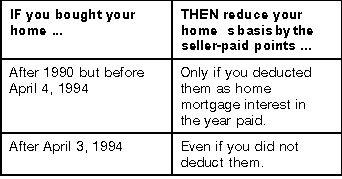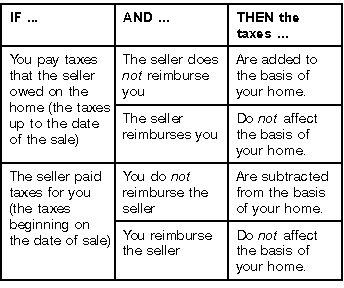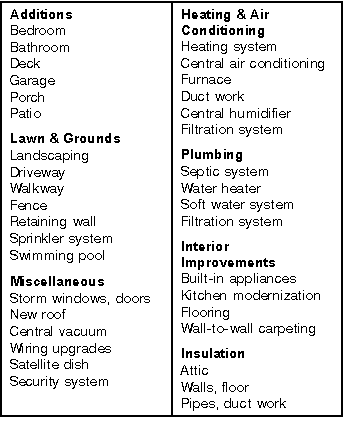You need to know your basis in your home to determine any gain or
loss when you sell it. Your basis in your home is determined by how
you got the home. Your basis is its cost if you bought it or built it.
If you got it in some other way (inheritance, gift, etc.), its basis
is either its fair market value when you got it or the adjusted basis
of the person you got it from.
While you owned your home, you may have made adjustments (increases
or decreases) to your home's basis. The result of these adjustments is
your home's adjusted basis, which is used to figure gain or
loss on the sale of your home.
To figure your adjusted basis, you can use Worksheet 1.
A filled-in example of that worksheet is included in the comprehensive
Illustrated Example at the end of this chapter.
Table 1 in this publication explains how to use the
worksheet in certain special situations.
The main topics in this section are:
- Cost as basis,
- Basis other than cost, and
- Adjusted basis.
Cost As Basis
The cost of property is the amount you pay for it in cash, debt
obligations, or other property.
Purchase.
If you buy your home, your basis is its cost to you. This includes
the purchase price and certain settlement or closing costs. Your
purchase price includes your down payment and any debt, such as a
first or second mortgage or notes you gave the seller in payment for
the home.
Seller-paid points.
If the person who sold you your home paid points on your loan, you
may have to reduce your home's basis by the amount of the points, as
shown in the following chart.

If you must reduce your basis by seller-paid points and you use
Worksheet 1 to figure your adjusted basis, enter the
seller-paid points on line 2 of the worksheet (unless you used the
seller-paid points to reduce the amount on line 1).
Settlement fees or closing costs.
When you bought your home, you may have paid settlement fees or
closing costs in addition to the contract price of the property. You
can include in your basis the settlement fees and closing costs you
paid for buying the home. You cannot include in your basis the fees
and costs for getting a mortgage loan. A fee for buying the home is
any fee you would have had to pay even if you paid cash for the home.
Settlement fees do not include amounts placed in escrow for the
future payment of items such as taxes and insurance.
Some of the settlement fees or closing costs that you can include
in your basis are:
- Abstract fees (abstract of title fees),
- Charges for installing utility services,
- Legal fees (including fees for the title search and
preparing the sales contract and deed),
- Recording fees,
- Survey fees,
- Transfer taxes,
- Owner's title insurance, and
- Any amounts the seller owes that you agree to pay, such
as:
- Certain real estate taxes (discussed in detail
later),
- Back interest,
- Recording or mortgage fees,
- Charges for improvements or repairs, and
- Sales commissions.
Some settlement fees and closing costs not included in
your basis are:
- Fire insurance premiums,
- Rent for occupancy of the house before closing,
- Charges for utilities or other services related to occupancy
of the house before closing,
- Any fee or cost that you deducted as a moving expense
(allowed for certain fees and costs before 1994),
- Charges connected with getting a mortgage loan, such as:
- Mortgage insurance premiums (including VA funding fees),
- Loan assumption fees,
- Cost of a credit report,
- Fee for an appraisal required by a lender, and
- Fees for refinancing a mortgage.
Real estate taxes.
Real estate taxes for the year you bought your home may affect your
basis, as shown in the following chart.

Construction.
If you contracted to have your house built on land you own, your
basis is:
- The cost of the land, plus
- The amount it cost you to complete the house, including:
- The cost of labor and materials,
- Any amounts paid to a contractor,
- Any architect's fees,
- Building permit charges,
- Utility meter and connection charges, and
- Legal fees directly connected with building the
house.
Your cost includes your down payment and any debt, such as a first
or second mortgage or notes you gave the seller or builder. It also
includes certain settlement or closing costs. You may have to reduce
your basis by points the seller paid for you. For more information,
see Seller-paid points and Settlement fees or closing
costs, earlier.
Built by you.
If you built all or part of your house yourself, its basis is the
total amount it cost you to complete it. Do not include in the cost of
the house:
- The value of your own labor, or
- The value of any other labor you did not pay for.
Temporary housing.
If a builder gave you temporary housing while your home was being
finished, you must reduce your basis by the part of the contract price
that was for the temporary housing. To figure the amount of the
reduction, multiply the contract price by a fraction. The numerator is
the value of the temporary housing, and the denominator is the sum of
the value of the temporary housing plus the value of the home.
Cooperative apartment.
Your basis in the apartment is usually the cost of your stock in
the co-op housing corporation, which may include your share of a
mortgage on the apartment building.
Condominium.
To determine your basis in a condominium, use the same rules as for
any other home.
Basis Other Than Cost
You must use a basis other than cost, such as fair market value, if
you got your home as a gift, from your spouse, as an inheritance, or
in a trade. If you got your home in any of these ways, see the
following discussion that applies to you. If you want to figure your
adjusted basis using Worksheet 1, see Table 1,
later, for help.
Fair market value.
Fair market value is the price at which property would change hands
between a willing buyer and a willing seller, neither having to buy or
sell, and both having reasonable knowledge of the relevant facts.
Sales of similar property, on or about the same date, may be helpful
in figuring the fair market value of the property.
Home received as gift.
Use the following chart to find the basis of a home you received as
a gift.
If the donor's adjusted basis
Part of federal gift tax due to net increase in value.
Figure the part of the federal gift tax paid that is due to the net
increase in value of the home by multiplying the total federal gift
tax paid by a fraction. The numerator (top part) of the fraction is
the net increase in the value of the home, and the denominator (bottom
part) is the fair market value of the home. The net increase in the
value of the home is its fair market value minus the donor's adjusted
basis.
Home received from spouse.
You may have received your home from your spouse or from your
former spouse incident to your divorce.
Transfers after July 18, 1984.
If you received the home after July 18, 1984, there was no gain or
loss on the transfer. Your basis in this home is generally the same as
your spouse's (or former spouse's) adjusted basis just before you
received it. This rule applies even if you received the home in
exchange for cash, the release of marital rights, the assumption of
liabilities, or other consideration.
If you owned a home jointly with your spouse and your spouse
transferred his or her interest in the home to you, your basis in the
half interest received from your spouse is generally the same as your
spouse's adjusted basis just before the transfer. This also applies if
your former spouse transferred his or her interest in the home to you
incident to your divorce. Your basis in the half interest you already
owned does not change. Your new basis in the home is the total of
these two amounts.
Transfers before July 19, 1984.
If you received your home before July 19, 1984, in exchange for
your release of marital rights, your basis in the home is generally
its fair market value at the time you received it.
More information.
For more information on property received from a spouse or former
spouse, see Property Settlements in Publication 504.
Home received as inheritance.
If you inherited your home, your basis is its fair market value on
the date of the decedent's death or the later alternate valuation date
if that date was used for federal estate tax purposes. If an estate
tax return was filed, the value listed for the property generally is
your basis. If a federal estate tax return did not have to be filed,
your basis in the home is the same as its appraised value at the date
of death for purposes of state inheritance or transmission taxes.
Surviving spouse.
If you are a surviving spouse and you owned your home jointly, your
basis in the home will change. The new basis for the half interest
that your spouse owned will be one-half of the fair market value on
the date of death (or alternate valuation date). The basis in your
half will remain one-half of the adjusted basis determined previously.
Your new basis is the total of these two amounts.
Example.
Your jointly owned home had an adjusted basis of $50,000 on the
date of your spouse's death, and the fair market value on that date
was $100,000. Your new basis in the home is $75,000 ($25,000 for
one-half of the adjusted basis plus $50,000 for one-half of the fair
market value).
Community property.
In community property states (Arizona, California, Idaho,
Louisiana, Nevada, New Mexico, Texas, Washington, and Wisconsin), each
spouse is usually considered to own half of the community property.
When either spouse dies, the fair market value of the community
property generally becomes the basis of the entire property, including
the part belonging to the surviving spouse. For this to apply, at
least half the value of the community property interest must be
includible in the decedent's gross estate, whether or not the estate
must file a return.
For more information about community property, see Publication 555,
Community Property.
Home received in trade.
If you acquired your home in a trade for other property, the basis
of your home is generally the fair market value of the other property
at the time of the trade. If you traded one home for another, you have
made a sale and purchase. In that case, you may have realized a gain.
See Trading homes, earlier, for an example of figuring the
gain.
More information.
For more information about basis, get Publication 551.
Adjusted Basis
Adjusted basis is your basis increased or decreased
by certain amounts.
To figure your adjusted basis, you can use Worksheet 1.
A filled-in example of that worksheet is included in a comprehensive
Illustrated Example at the end of this chapter. Table
1 explains how to use the worksheet in certain special
situations.
Table 1. How to Use the Adjusted Basis of Home Sold Worksheet in Special Situations
Table 1 (continued)
Increases to basis.
These include any:
- Additions and other improvements that have a useful life of
more than 1 year,
- Special assessments for local improvements, and
- Amounts you spent after a casualty to restore damaged
property.
Decreases to basis.
These include any:
- Gain you postponed from the sale of a previous home before
May 7, 1997,
- Deductible casualty losses,
- Insurance payments you received or expect to receive for
casualty losses,
- Payments you received for granting an easement or
right-of-way,
- Depreciation allowed or allowable if you used your home for
business or rental purposes,
- Residential energy credit (generally allowed from 1977
through 1987) claimed for the cost of energy improvements that you
added to the basis of your home,
- Adoption credit you claimed for improvements added to the
basis of your home,
- Nontaxable payments from an adoption assistance program of
your employer that you used for improvements you added to the basis of
your home,
- First-time homebuyers credit (allowed to certain first-time
buyers of a home in the District of Columbia), and
- Energy conservation subsidy excluded from your gross income
because you received it (directly or indirectly) from a public utility
after 1992 to buy or install any energy conservation measure. An
energy conservation measure is an installation or modification that is
primarily designed either to reduce consumption of electricity or
natural gas or to improve the management of energy demand for a home.
Improvements.
These add to the value of your home, prolong its useful life, or
adapt it to new uses. You add the cost of additions and other
improvements to the basis of your property.
Examples.
Putting a recreation room or another bathroom in your unfinished
basement, putting up a new fence, putting in new plumbing or wiring,
putting on a new roof, or paving your unpaved driveway are
improvements. An addition to your house, such as a new deck, a
sunroom, or a new garage, is also an improvement.
The following chart lists some other examples of improvements.

Improvements no longer part of home.
Your home's adjusted basis does not include the cost of any
improvements that are no longer part of the home.
Example.
You put wall-to-wall carpeting in your home 15 years ago. Later,
you replaced that carpeting with new wall-to-wall carpeting. The cost
of the old carpeting you replaced is no longer part of your home's
adjusted basis.
Repairs.
These maintain your home in good condition but do not add to its
value or prolong its life. You do not add their cost to the basis of
your property.
Examples.
Repainting your house inside or outside, fixing your gutters or
floors, repairing leaks or plastering, and replacing broken window
panes are examples of repairs.
Exception.
The entire job is considered an improvement if items that would
otherwise be considered repairs are done as part of an extensive
remodeling or restoration of your home.
 Recordkeeping.
You should keep records to
prove your home's adjusted basis. Ordinarily, you must keep records
for 3 years after the due date for filing your return for the tax year
in which you sold your home. But if you sold a home before May 7,
1997, and postponed tax on any gain, the basis of that home affects
the basis of the new home you bought. Keep records proving the basis
of both homes as long as they are needed for tax purposes.
Recordkeeping.
You should keep records to
prove your home's adjusted basis. Ordinarily, you must keep records
for 3 years after the due date for filing your return for the tax year
in which you sold your home. But if you sold a home before May 7,
1997, and postponed tax on any gain, the basis of that home affects
the basis of the new home you bought. Keep records proving the basis
of both homes as long as they are needed for tax purposes.
The records you should keep include:
- Proof of the home's purchase price and purchase
expenses,
- Receipts and other records for all improvements, additions,
and other items that affect the home's adjusted basis,
- Any worksheets you used to figure the adjusted basis of the
home you sold, the gain or loss on the sale, the exclusion, and the
taxable gain,
- Any Form 2119, Sale of your Home, that you filed
to postpone gain from the sale of a previous home before May 7, 1997,
and
- Any worksheets you used to prepare Form 2119, such as the
Adjusted Basis of Home Sold Worksheet or the Capital
Improvements Worksheet from the Form 2119 instructions.
Previous | First | Next
Publication Index | 2001 Tax Help Archives | Tax Help Archives | Home
